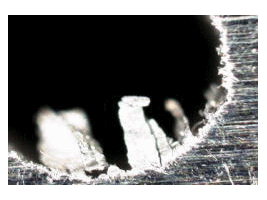1-31-1 Yokoyamadai,
Chuo-ku, Sagamihara City,
Kanagawa pref. 2520241
- Cotnact
- +81-42-7117721
Principle of ultrasonic deburring and cleaning
- Do you have trouble removing burrs?
- Labor cost reduction Quality stabilization Competitiveness enhancement
- A completely new deburring technology The principle of ultrasonic deburring technology is introduced here.
- Patent granted!
Creation of globular nebula cavities(microvacuum nuclei)
Deburring is not possible with gas nebula type cavities. This is because the positive and negative shocks generated during cavity creation and annihilation are too weak. To create a spherical nebula cavity, it is necessary to remove enough dissolved air from its cleaning liquid (e.g.,water)..

Perform correct cavitation control.
It is necessary to follow the basics of proper ultrasonic cleaning.
(See “True Ultrasonic Cleaning Equipment.”) An ultrasonic tank must be capable of stably generating cavities generated by ultrasonic waves.
The tank must be capable of accurately managing the cavitation control. If the tank is not capable of this, not only can burrs not be removed, but the welds of the tank may crack and the ultrasonic transducer may be destroyed.

Deburring as stress fracture (fatigue fracture)
It is necessary to follow the basics of proper ultrasonic cleaning.
(See “True Ultrasonic Cleaning Equipment.”) An ultrasonic tank must be capable of stably generating cavities generated by ultrasonic waves.
The tank must be capable of accurately managing the cavitation control. If the tank is not capable of this, not only can burrs not be removed, but the welds of the tank may crack and the ultrasonic transducer may be destroyed.

Deburring as edge finishing process
Processing technology is advancing rapidly, and more and more customers are turning to ultrasonic deburring instead of conventional deburring methods.
Most of these customers have very small burrs from cutting, pressing, molding, and other processes, and even when viewed with a microscope, it is often difficult to
distinguish them from the main body of the product. Currently, the number of burrs within a few microns is increasing.
In this case, the positive and negative shock waves of the cavity must be applied to the burr without any limit, causing a crack at the relatively fragile boundary between the body and the burr, which must then be removed. This is truly the field of precision edge finishing.
Difference from ultrasonic cleaning
In the case of cleaning, it is not necessary to make the ultrasonic cavity shock wave
this powerful. Also, in the case of cleaning, relatively many objects have oil or other
substances attached to them. Strong shock waves are not necessary to remove oil.
Therefore, in the case of cleaning, the temperature is raised slightly to increase the
number of cavities.
The higher the temperature, the smaller the shock wave, but the greater the
number of cavities.
Deburring is generally performed at temperatures below 10 degrees Celsius.
Also, ultrasonic power density should be at least
twice that of cleaning, 2W/cm 2 or higher.
Where do the removed burrs go?
In general, ultrasonic deburring doubles as precision cleaning. In order to generate
enough cavities to remove burrs, removal of contamination is usually performed at
the same time. The removed micro burrs are then circulated and filtered in the same
way as in cleaning, and returned to the original ultrasonic tank through a filter. In
other words, ultrasonic deburring doubles as precision cleaning.
What is used for deburring fluid?
Generally, water is used, but hydrocarbon solvents and other solvents with low
surface tension can also be used. However, we recommend using water (pure water
or city water) as much as possible.
All rights reserved.